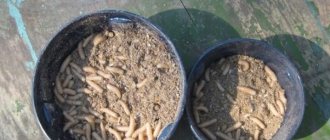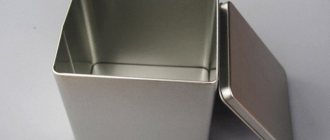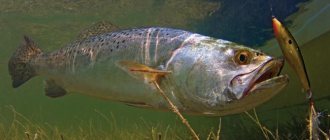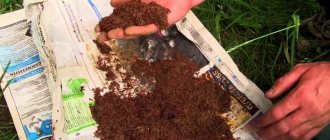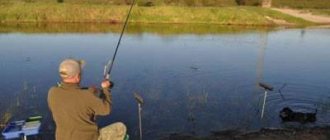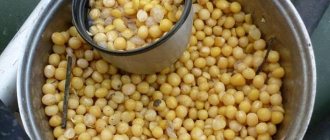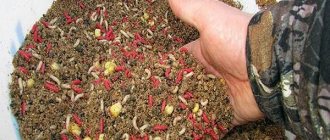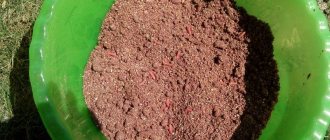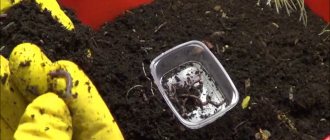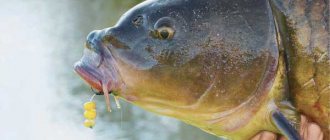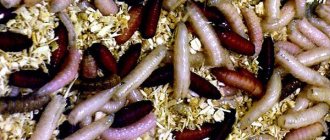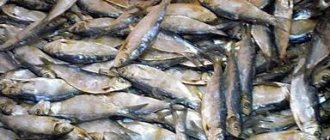Avid fishermen assure beginners that a good catch does not depend on the weather and time of year, but on the right choice of bait and lure. Bloodworms have long been considered one of the most effective baits, especially for winter fishing.
It is important to know not only how and what kind of fish to fish with the help of larvae, but also how to obtain and preserve bloodworms in various conditions at home and fishing.
Feeding small bloodworms have also found their place in fishing practice
Educational program for novice fishermen: what is a bloodworm, photo and description
Bloodworms (raspberries) are the larvae of mosquitoes from the family Chironomidae. The body of the worm-like insect is painted in red tones, and the head is dark. The tail is forked. The length of a mosquito larva can reach 10-25 mm. The reddish tint to the body is given by hemoglobin, which is contained in the blood of the insect.
Depending on their size, raspberries are divided into several types:
- Large (attached) type of bloodworm. The size of the larvae that belong to this category is quite large. You can find them in the silted soil of a pond or lake. Almost never found in rivers.
- Limanny . It lives in southern salty estuaries, in which there are significant deposits of organic matter at the bottom.
- Small . The length of the larvae of this species reaches 10 mm. Insects live on the bottom of rivers in places of industrial discharges.
Note! Mosquito larvae do not bite people and are not a nuisance.
Bloodworms for fishing, as bait and bait
Anglers use bloodworms as bait at any time of the year. If you bait the larva correctly, it will move on the hook for a long time, attracting the attention of the fish. You can use special hooks with a spring clip, with which you can fix the raspberries without piercing them.
In addition, bloodworms are added to the bait mixture and a small portion of larvae is dropped into the hole to lure a school of fish.
Note! Bloodworms can be used as an independent attachment or in combination with maggots.
Where to look for bloodworms and how to get and wash mosquito larvae yourself
Malinka lives in muddy areas of the bottom of streams, ponds, slow-moving rivers and lakes. Mosquito larvae are able to survive even in polluted water bodies. Insects build housing for themselves by gluing mud together with saliva secreted from the salivary glands.
In order to wash mosquito larvae yourself, you should use a sieve and a net with a fine mesh. Depending on the size of bloodworms needed, it is worth selecting the size of the sieve mesh. Experienced fishermen recommend using a sieve with a mesh size of 1.5-2 mm to wash baited specimens. To obtain bait specimens, you can use smaller meshes.
How to easily and quickly get bloodworms in a few minutes and wash the larvae correctly:
Step-by-step process for washing raspberries using a sieve:
- First of all, fishermen use a sieve to scoop up silt from the bottom of the reservoir and lift it to the surface of the water.
- The sieve is shaken so that the silt is washed out. The larvae, along with large debris, will remain in it.
- The sieve is removed from the water. Its contents are left in the sifting tool for a couple of minutes to dry.
- The sieve is re-immersed in water. Dried larvae float to the surface. They are collected using a net. This is the so-called bloodworm washing process.
Wash bloodworms in large quantities using a pump
As part of the fishing, right there on the spot, they wash the bloodworms using a device - a guitar, which is used to scoop out the soil along with the larvae and wash them in a container of water.
How to wash bloodworms is an effective old-fashioned way to get raspberries in the winter:
Do not throw away sorted small specimens; they can be used as bait, and large ones can be used as bait.
How to keep bloodworms in summer
How to preserve bloodworms in the summer
Preserving bloodworms on hot summer days is a paramount task for an angler who retains hope for a more or less decent catch. In general, it is not difficult, you just need to put in a little work, and the fishing will not be marred by the lack of a bait and an important component of the bait.
Improvised thermos bag
There is no doubt that you need to take bloodworms for fishing, or any other bait, at least in an isothermal container with cooling elements. But it is often not uncommon that either there is no such bag, or it is occupied with food, where the better half will not allow “those terrible red worms” within a cannon shot. Then an improvised refrigerator will help out. A huge plastic bottle (1.5, or preferably 2 liters) of frozen water (the water can then be used for its intended purpose) is wrapped in several layers of crumpled newspaper and placed at the bottom of a huge plastic bag, and a nozzle (bloodworm or maggot) is placed on top, except this one wrapped in newspapers. Newspapers (and, beyond competition, those printed on non-glossy and coated paper) are an adsorbent, absorbing the perspiration that appears from bloodworms. To be sure, the entire structure can be wrapped in narrow foam rubber, which serves as a heat insulator, and placed in another bag. If a bottle of water is perfectly frozen, then the temperature close to zero remains for at least half a day, which allows you to deliver the nozzle to the pond completely fresh.
Big bloodworm
The first thing you need to do when you arrive at the fishing spot is to take care of the bloodworms. how to prepare bait for bait The sooner it is placed in its usual habitat, in other words, in the water, the better the result will be. To begin with, you need to keep the bloodworms in the air for a little while, so that it warms up a little and avoids heat stroke from moving into sufficiently warm water. In most cases, it is enough to hold the package with bloodworms in the shade for about five minutes, after which it is possible to rinse it with water from a reservoir. If most of the larvae are alive, they are immediately passed through a sieve for punching. A sieve is suitable for both bait (with a mesh size of 2-3 mm) and a special one for breaking through bloodworms. It’s easy to make it yourself by nailing a mesh with a mesh of a suitable size onto a square frame made of wood or foam plastic; you need to make it from “stainless steel”, and this makes such a floating mesh universal for any container. Once most of the bloodworms are in the container, it is better to throw out the remainder; the sedentary larvae will all die soon. If necessary, the punching procedure can be repeated. You should not sift through a huge amount of bloodworms at once, it is better to do this in portions of 20-40 g. Then the bloodworms are divided: a small number of larvae are left for catching, the rest are placed in a container with a huge amount of water and placed in the shade. The water needs to be changed occasionally, avoiding strong heating. To cool the container, wrap it in a wet towel. In this form, sometimes passing the bloodworm through a sieve and removing dead larvae, it can be preserved for fishing for up to several days. At the dacha, where there was no refrigerator, I kept bloodworms in the underground. In this way, it was possible to preserve the gentle larvae for up to a month; the only important thing is to remember to go to the fire pond once a day, wash them and change the water in the bucket. The bloodworms that are on the table with the nozzle get very hot in hot weather. An umbrella for a table with an attachment and a little trick will help to mitigate this negative factor: sometimes it is necessary to add thawed water from a bottle to the water with bloodworms. This is why it is fundamentally important to use either mineral water without gas or settled tap water for freezing.
Small bloodworm
When you go out for a couple of days, a small bloodworm is especially needed in the first days of fishing, at a time when you need to attract fish to the feeding point. In most cases, small bloodworms are stored in newspapers, which absorb excess moisture and prevent the larvae from caking. To store small bloodworms, it is very important to change the newspapers in time, and all of them, and not just the top one, as is often done. The larvae are evenly distributed over the newspaper in a narrow layer. As long as the bloodworm is not wet, it is able to breathe atmospheric air and exist completely normally. how to prepare bait and bait for fishing When the larvae begin to cake, their temperature instantly increases and they soon die. peas as a nozzle and bait Small bloodworms, like large ones, should be protected from sunlight; it is best to lay out the larvae wrapped in newspapers on the grass in the shade and cover with a wet towel.
Southern bloodworm
The so-called southern bloodworm has now become a lifesaver. It is found in brackish waters, much smaller than the small bloodworms we are used to, but at the same time much more tenacious. In addition, in lightly wet, clean newspaper, at high air temperatures, it feels excellent for almost seven days. It must be stated that sellers of bloodworms do not bother themselves with the worries of rearranging the bloodworms; therefore, immediately after purchase, you need to change all the newspapers in which it was wrapped. I remember a couple of years ago, at a time when the “southern” just appeared on sale, many doubted its suitability for fishing, but countless experience in competitions dispelled these fears. In any case, it is better to use a live southern bloodworm than not to have it at all or to have an unimportant one from the Moscow region, despite the fact that the controversy regarding its use in the winter period has not subsided to this day. If such bloodworms have been stored for a long time and have acquired an unpleasant odor (despite the fact that the larvae remain alive), it can be washed in a pond in a bag for storing small bloodworms. The larvae, having “inhaled” oxygen, come to life and “work” excellently. Southern bloodworms are perfectly preserved in the ground for bait, and the moisture content of the substance is probably quite low; The liquid contained in the package with soil is fully sufficient. If your fishing trip unexpectedly breaks down at the very last moment, you can save the purchased bloodworm for your next trip by freezing it in the refrigerator. It goes without saying that it will be unsuitable for bait, but it will serve excellently as a starting portion of bait. Bloodworms can be frozen by mixing it with ground bait, which should be as dry as possible. In this case, I deliberately use dried, sifted and crushed clay. The bloodworms are covered with a large amount of clay, carefully mixed and... spread out in a thin layer into plastic bags and freeze. The speed of freezing is responsible; the faster, the better. It is possible to mix the larvae with potato starch, but the disadvantage of starch is that the bloodworms must be transported frozen to the fishing site, otherwise it is difficult to mix the melted mass with the bait. Before adding to the bait, properly frozen bloodworms are crushed by hand without large lumps or effort. The only drawback to the method of storing bloodworms is to obtain the consent of the wife, who, however, can swear a promise that the frozen bloodworms, unlike the nimble maggots, will not crawl around the refrigerator. All of the listed methods for storing bloodworms are excellent for both spring and autumn, allowing you to provide yourself with excellent bait for a couple of days.
how to store bloodworms for a long time
How long to preserve bloodworms at home - in the refrigerator, potatoes, newspaper...
You can store mosquito larvae at home in the refrigerator, perhaps this is the simplest and most popular method; the shelf life should not exceed 14 days. Before you put the insects in the refrigerator, you need to sort them out and throw away the dead ones.
After this, the raspberries should be placed on damp newspaper. The edges of the paper are folded and the larvae are sent to the refrigerator. Every 3 days it is necessary to sort through the bloodworms, removing dead ones. You can also store bloodworms in a container filled with drunken tea.
You can effectively store bloodworms in newspaper for quite a long time - you need to lightly moisten it with water and store it in a cool place in the refrigerator, basement or garage
Often fishermen need to keep mosquito larvae alive throughout the winter; what can be done with the bloodworms in this situation? Experienced fishermen recommend placing insects in a basket made of metal mesh with a fine mesh and lowering them into a plastic container, the upper part of which has been previously cut off. It is important to systematically check bloodworms, selecting dead ones. It is also necessary to provide favorable aeration and periodically feed the raspberries with sugar.
Storing bloodworms in a cut potato tuber will preserve the larvae for 7-10 days for fishing in winter and up to 3-5 days in summer
How to store bloodworms in potatoes:
How to store bloodworms
How to preserve bloodworms in the summer, in hot weather? is a very important question for anglers who count on a decent catch. Bloodworms are one of the best baits and groundbaits, including in the summer. In autumn, winter and spring, it is unrivaled as a bait, since fish in cold water gravitate more towards meat. In the summer, bloodworms are usually used in large quantities in large quantities and also in bait. Therefore, the issue of storing large quantities of bloodworms at high temperatures is urgent.
Change newspapers for bloodworms
Paper absorbs moisture, bloodworms in newspapers are dried and stored longer.
Bloodworms are usually sold packaged in newspapers. But sellers do not bother themselves with timely replacement of newspapers, so purchased bloodworms must be transferred to fresh, dry newspapers.
The main thing during storage is to prevent the larvae from sticking together. If this happens, then the temperature inside the pile of bloodworms quickly rises and the bloodworms die. On the newspaper, the living ones crawl away, forming a thin layer. In this position, the larvae can breathe atmospheric air and exist normally for several days. Once dampened, newspapers must be changed, and not just the top one, but the entire layer at once.
Glossy and coated sheets of magazines, etc. cannot be used to store larvae.
Bloodworms can be frozen
There is a situation when bloodworms are prepared, but fishing is postponed. In order not to lose the larvae, they can be frozen and then used as part of the starter feed on the next fishing trip. But before freezing, they need to be mixed with a large amount of very fine and dry soil.
Having mixed and broken the bloodworms with fine and dried clay, they are placed in plastic bags and stored in the freezer until the next trip.
Transportation of bloodworms chilled
To transport live bloodworms, you need a special thermos, inside of which a low temperature could be maintained for a long time. But not everyone has such a device, and it is not always possible to purchase it.
A regular bag with a frozen 1.5 - 2 liter bottle of water, which is wrapped in a layer of newspaper and placed at the bottom of the bag, will help. Bloodworms in newspapers, and other bait, are placed on top.
To store it in this position for a long time, it is recommended to make a thermos from the bag itself. You need to wrap everything inside in a heat insulator, which can be used as polyethylene foam, sold in hardware stores as a backing for laminate flooring or foam rubber.
When fishing, it is better to store bloodworms at the bottom of the reservoir.
A way to almost endlessly store live bloodworms while fishing is to place them at the bottom of a reservoir in a natural environment. To do this, you need to get a bag made of durable nylon mesh with very small cells, put bloodworms in it, and lower it to the bottom, to a depth of more than 1.5 meters. It's cool there.
But you need to find such a fabric - like the one through which flour is sifted - and make a bag. In general, a similar storage method is needed if fishing lasts more than 3 days or weeks. In a simplified version, bloodworms can be stored in newspapers laid out in the grass, or in a container of water on the shore.
Other ways to preserve small bloodworms in summer
Small food bloodworms, which are needed for the first few days of fishing to be added to the bait, can be stored in a thin layer in newspapers, which are laid out in the shade and covered with a slightly damp cloth so as not to overheat.
You can also store it for a day or more in soil, which must be carefully sifted through a fine sieve. A minimal amount of soil is mixed with the bloodworms, such that the larvae just separate. Then the soil must be slightly sprinkled with water so that it becomes slightly moist, otherwise the larvae will dry out and die. All this is also wrapped in newspapers, moistened with water and stored in the shade.
Large bloodworms - special preservation in water
Large bloodworms used for bait must maintain maximum survivability and show fighting qualities on the hook. It is best to store this bait in water when fishing. After transportation in a chilled state, the newspapers are unrolled and the bloodworm is allowed to warm up in the air for at least five minutes, so that it does not die from temperature changes when immersed in water.
You also need to pay attention that it is better to use the following to bait a hook. There is the most tenacious species of bloodworm, called “Southern”. It lives in brackish waters and is highly resilient. It can be stored in newspapers on the shore of a reservoir without disappearing for more than a week.
Breaking and punching bloodworms
Before using bloodworms in groundbait or for bait, you need to do the following. Before adding small larvae to the bait, it is advisable to break them up, that is, separate the larvae. For this, either a special powder or very fine, ground dry clay is used.
Then the bloodworms need to be reseeded - to separate the dead larvae. For this, a special sieve is used to break through the bloodworms. Any stainless steel mesh with a cell size of 2 by 3 millimeters is suitable. This mesh can be lined around the perimeter with foam or wood to create a floating structure. Live larvae pass through the sieve, but dead ones remain. It is better to carry out punching in portions - 20 - 40 grams each. bloodworm. But sometimes it can be difficult to choose such a mesh, and you don’t want to bother with further production yourself... It turns out that you can go to a pet store and buy a plastic trough with approximately the same cell for cheap. It turns out to be an excellent way to push bloodworms through a plastic animal trough...
How to more conveniently lay out and prepare larvae for fishing
The sifted live bloodworms are divided into two portions - one goes into a box for immediate use. The remaining larvae should be stored during fishing.
To prevent rapid overheating of a small portion of bloodworm on the fishing table, it is cooled with water. And here a bottle of frozen water will help, unless of course the water in it is not mineral, but ordinary - purified. Thawed cold water is simply poured into the container for the nozzle.
Another method of storing a large already sifted portion, which is used more often. The bloodworms are placed in a container with a large amount of water, which is placed in the shade. To prevent overheating, the container can be wrapped in a wet rag; as the water evaporates from the rag, the walls of the container cool. Bloodworms can be stored in water for several days. It is necessary to periodically change the water and sift the bloodworms, removing dead larvae.
How to separate live bloodworms from dead ones, small bait from bait
Living larvae strive to get out into the holes, unable to tolerate confined spaces. Knowing this feature, you can quickly separate living insects from dead ones. Having collected settled rainwater into a deep basin, you need to cover it with a mesh, the cell size of which is 2-3 mm. The larvae are scattered onto a net and lightly immersed in a container filled with water. The raspberries should be completely submerged in liquid.
After 15 minutes, all living insects will seep through the sieve and end up at the bottom of the basin. The dead ones will remain in the net. They can be thrown away or used for bait mixture.
Sorting large and small bloodworms is quite simple. To do this, pour mosquito larvae into a sieve and immerse the instrument in a container filled with water. Small raspberries will pass through the holes and end up in the container, while larger insects will remain in the sieve.
Large bloodworm in a blood bottle
Review of ready-made baits for winter
To all baits, no matter ready-made or homemade, you should always add a nozzle and bait with which you are currently catching, for example, a handful of bloodworms.
Usually four types of branded Dunaev winter mixtures DUNAEV-READY are used. Here you can immediately mention “ Universal ”. It is usually used on all types of winter fish. The bait is dark brown in color. This mixture resists frost well, that is, it does not freeze as quickly as other mixtures. It also does not spoil for a long time. And this is what is called “rancid” bait, which will not attract fish, but will rather scare them away.
Tips for fisherman: How to wind fishing line on a winter fishing rod - How to best use
The “Motylnaya” bait attracts winter fish very well, but it should be taken into account that along with peaceful fish, predators can also approach the hole. This bright red bait contains about 10% natural bloodworms.
The bait mixture "Bream" has an excellent ability to lure bream to the hole, but there is one unpleasant moment. This ability of this bait may not manifest itself in all reservoirs. This must be verified experimentally.
The bait "Roach" is also universal. It attracts almost all fish, but it contains components with a dusting effect. Therefore, small things can also fit into the hole.
Fishermen are often concerned about how to properly store bloodworms so that the fish will enjoy them for as long as possible. Storing bloodworms at home is quite difficult. It crushes easily, but there are several ways to keep the bloodworm alive. These methods are somewhat similar.
Photo 1. Extraction of bloodworms.
This method is not the only one. Catching bloodworms can be done in a gauze cloth with large holes or in a thin-woven bag. The trick is that you need to put a piece of fish, meat and a weight in the bag that allows you to lower it to the very bottom. After several hours, the bag is removed from the water, and the accumulated larvae are collected by hand.
Experienced fishermen advise how to catch bloodworms on a device such as a string. A fishing line or wire is pulled tightly onto the frame and used to comb the bottom of the reservoir. The strings touch the larvae, and they wrap themselves in rings around them. Then the rings are washed off into a tank or bucket of water. Unfortunately, this method damages many larvae.
When sorting, the bait should be placed in a fine-mesh sieve. Then the sieve should be immersed in a container that is first filled with water. After a short period of time, small larvae will crawl through the cells into the container, but large ones will remain.
At the selected location, a hole is cut approximately 1.00 - 1.50 x 1.00 - 1.50 meters. The hole can be cut with a sharp hatchet. During the cutting process, the resulting crumbs are immediately removed from the future ice hole. Until the edges are cleaned, water should not be allowed to enter the hole. If the water rises, further cleaning of the ice hole becomes an unpleasant task. For such circumstances, it is necessary to provide a tool like an ice pick.
How to breed larvae
To start breeding mosquito larvae, you will need to allocate 2 rooms for this purpose. The first will contain mosquitoes, and the second will house their larvae. A layer of river silt is poured into the buckets, the thickness of which reaches 15-20 mm. The sludge is washed with boiling water, after which cold water and a small amount of yeast are added, which will be required to feed the raspberries.
The composition is thoroughly mixed until the consistency resembles the thickness of sour cream. Every 14 days it is necessary to add small pieces of yeast to the sludge.
In the room where mosquitoes live, you should place a bowl of water. The insects will lay eggs there, which will soon hatch into larvae. The raspberries need to be caught with a sieve, transferred to another room and placed in a container filled with a layer of silt.
How to store larvae while fishing
When fishing, insects are exposed to low or high temperatures, which can cause the death of the larvae.
Cold storage
For winter fishing you need to take bloodworms in portions (the amount that you plan to use). The larvae are placed in a foam moth tray. It is worth considering that foam plastic is endowed with good thermal insulation properties. The moth bottle is sent for storage in the inner pocket of the jacket. The larvae should be systematically inspected. Overheated or frozen bloodworms will become lethargic. In this case, the box will need to be moved to one of the pockets.
In winter you need to use special bloodworms
Storing bloodworms in the heat during summer fishing
On hot days, if stored improperly, bloodworms often dry out. At this time of year, it should be wrapped in a damp cloth and placed in an open food container. The container is transferred to a shaded place that is well blown by the wind. Moisture will begin to evaporate from the surface of the wet fabric and will cool the larvae. The cloth needs to be moistened periodically. Raspberries can be stored in this way for 24-36 hours.
Grandfather's secret on how to prepare bloodworms for winter fishing so that the bite is 5 times greater
But all you need is one simple remedy! I don’t know what’s the catch here, what’s the trick, but the fish actually grab such pre-prepared bloodworms many times more often and more.
Fish line up for such a catchy bloodworm, just like in Soviet times in stores for sausage!
How to prepare bloodworms for catching winter fish - make them more catchy
Purchased bloodworms must first be sorted for unsuitability. Dead and dead - for bait.
Then prepare the bloodworm as appropriate. We take a piece of wrapping material that is used to wrap household appliances in boxes. Some kind of film, foamed or something.
We cut it out exactly to fit the moth tray.
And now attention! You will need a bottle of iodine, which is available at the pharmacy and sells for mere pennies (10-15 rubles). You also need a cotton swab.
We moisten this stick in an iodine solution and apply it to the foam film without fanaticism - just a few stripes and dots.
If you have an iodine pencil at home, you can draw with it.
Place this film in a bloodworm tray and place the bloodworms there.
It is necessary to prepare bloodworms for winter fishing in this old-fashioned way in advance, in the evening. And take exactly as much as you need for fishing.
Overnight the bloodworm will become a super bait! It will be saturated with the smell of iodine and will become very attractive to fish.
The roach already bites without any additives, but with such prepared bloodworms it will bite even better and more often. Striped robbers are also not averse to tasting such “sweet” bloodworms.
This is also interesting: How to make a jig catchy?!
So, if you have the opportunity, be sure to try preparing bloodworms for winter fishing in this way. Just check it out. But I can tell you for sure that you will not be disappointed!
How to bait and fish with larvae
There are several options for how to put a bloodworm on a hook. The most popular of them are:
- The hanging bloodworm method . The larva is pierced beyond the 3rd segment (from the head). You can attach 1 or 2 larvae to one hook.
- Ring . The larva is pierced with the sting of a hook behind the head and tail segment. The bloodworm will hang in the water column or lie on the bottom surface.
- Stocking method . The sting is inserted into segment 2 (from the head) and the raspberry is carefully placed on the hook. The sting must be hidden inside the insect's body.
- Bunch . 4-5 raspberries are attached to the fore-end using elastic bands and special devices. This method allows you to avoid injury to the nozzle. The larvae will remain alive and mobile for a long time.
- Across . The mosquito larva is pierced in the middle with a sting, which should remain outside.
How to plant bloodworms without damaging the larvae - video tips:
Catching fish with bloodworms is a fascinating process that, with the right approach, can be handled not only by an avid fisherman, but also by an amateur. Mosquito larvae attract the attention of roach, crucian carp, rudd, pike, perch, carp, tench, bream and other types of fish.
Bloodworms are natural food, so they do not cause suspicion among the inhabitants of the reservoir. Experts recommend placing 2-3 larvae on a hook. A bouquet of raspberries will look delicious. The fish are unlikely to swim past.
How to use as bait
By adding mosquito larvae to the bait mixture, you can increase its nutritional value and detain a school of fish in the fishing zone. To prepare bait you will need to purchase:
- 200 grams of breadcrumbs;
- 150 grams of millet;
- 150 grams of corn;
- 150 grams of pearl barley.
Millet, corn and pearl barley are boiled. Place all the ingredients in a deep container and mix them. To give the bait mixture an aroma that attracts fish, it is worth adding 50 grams of crushed bloodworms to the mixture.
Live components are chopped before adding bait to the feeder, since cut mosquito larvae are subject to rapid oxidation (in summer). Against this background, the porridge will quickly disappear.
Advice! You should not pour whole bloodworms into the bait, since the active larvae will crawl to the bottom of the bucket and the bait mixture will have to be stirred frequently.
Winter bloodworm prey
Extraction of bloodworms with a string
String mining involves the use of a device in the form of a frame attached to a pole. The size of the frame will depend on the size of the hole. The frame is wrapped with fishing line at least 1 millimeter thick with the distance between the strings no more than 2 centimeters. The extraction of bloodworms occurs in the following way: the frame is lowered to the very bottom and moved along it, thus the bloodworm located in the silt is caught on the fishing line.
Using a bucket when collecting bloodworms
This method is one of the simplest with a minimum of equipment. All you need is a bucket and a lighted fire. The principle of this method is as follows: a bucket is lowered into the water, silt is scooped up from the bottom, and then the bucket with silt is placed on a fire made in advance. When the water heats up, the bloodworm larvae will begin to rise to the surface, from where they can be easily collected.
For meat or fish
This method is the slowest in obtaining bloodworms. A piece of meat or fish is wrapped in gauze to form a bag that resembles a bag. This bag is tied to a rope or cord and thrown into the water. The next day he takes it out and unfolds it. In this bag, in addition to a piece of meat or fish, bloodworms should be found. This method is not common among fishermen, but in ancient times bloodworms were caught in this way.
A depth gauge is needed to determine depth, search for holes, and study the bottom topography. A weight or a feeder on a cord can handle its function. For convenience, tie knots every meter.
Firstly, ice is a potentially dangerous place. Do not go out on the ice if its thickness is less than 6 cm (ideally more than 10 cm). When planning winter fishing, keep in mind that in calm weather, 2.5 mm of ice freezes for every degree below zero per day. For example, at -8 degrees, 2.5 x 8 = 20 mm = 2 cm of ice will freeze per day. Bring a partner with you, you may need help.
Secondly, the risk of hypothermia. Frost is the main limiter for novice subglaciers. But we knew that it wasn’t summer outside, we could handle it!
What are the advantages and disadvantages of winter fishing?
Winter fishing is an exciting, exciting and dynamic process.
You can walk on the ice to any place, to any depth of the reservoir, and fish in the most inaccessible fishing spots.
There are types of fish that can only be caught in winter, for example, whitefish, smelt, burbot.
There is no need to throw gear far. The fisherman is in complete control of the process.
Fishing without bait - a reelless method - is possible only in winter. This is an interesting and complex, even masterly method; it is not easy to learn. But you probably won’t return home without a catch.
Minus Celsius will naturally lead to freezing of the hole and freezing of ice on the fishing line. With experience in fishing comes the skill of conquering the cold: your hands will get used to deftly moving the tackle, you will learn how to protect the hole from freezing.
Additional equipment is required: tackle and attachments, an ice auger, a fishing box, a tent with a stove and much more. But once you buy everything you need, you can easily devote time to your favorite activity.
Many fish hibernate in winter, so species diversity is somewhat less than in summer. And in the dead of winter, some fish completely lose interest in bait. There are ways to stir up lazy fish, and this only increases the excitement
Tips for fisherman: How to make a diverting leash on a winter fishing rod - How to best use
Thoughtful preparation will help you choose the optimal equipment, equipment, accessories, and take into account important details.
Clothes are multi-layered. The bottom layer is natural underwear or thermal underwear. The next layer is a fleece or wool set, a woolen sweater with a high neck. The top layer should be windproof and waterproof, but at the same time wick away moisture and not restrict movement. A jacket made of membrane fabric is preferable: it will protect from wind and snow and allow sweat to evaporate. Choose a mid-thigh model, always with a deep hood.
Prefer pants with straps - overalls - this will allow you to squat and bend over and over again without freezing your lower back.
Shoes - boots made of waterproof material, for example PVC, with an inner woolen boot, with high non-slip soles, or special boots. Wool felt boots with high rubber galoshes are not bad.
A cap. Some experienced fishermen prefer earflaps coated with waterproof fabric - they cover the ears and neck. Sports woolen hats with a tight knit are also comfortable. You can put a hood on top.
Comfortable gloves with three cut fingers. You can wear mittens on top. Bring spare gloves in case you get wet.
The knife is multifunctional and scissors should always be in the drawer.
A flashlight is needed for night fishing. The LED headlamp is convenient - it “looks” in the same direction as you, and your hands are free. Take a spare set of batteries; they discharge faster in cold weather.
A depth gauge is needed to determine depth, search for holes, and study the bottom topography. A weight or a feeder on a cord can handle its function. For convenience, tie knots every meter.
A dry cloth or towel to wipe wet objects and hands and prevent them from becoming icy. Put it behind your boot, it will always be at hand.
Mothworm for live bait. It could be a foam box, a birch bark box, or even a matchbox. In the inside pocket of your jacket, your worm and maggot will be warm and will remain active and attractive to the fish.
Metal mesh with handles - for catching. A plastic bag will not work due to its fragility at sub-zero temperatures.
Metal feeder in the shape of a cube or cone.
Yawner and extractor for opening the fish's mouth and removing the hook when swallowing it deeply.
Container for live bait. There is a large selection of special containers (cannes). For the initial stage, a 6-12 liter plastic bottle with a handle is also suitable.
Interesting little things that will make fishing more comfortable: salt heating pad, heated insoles, knee pads (useful during active fishing when you have to stand near the hole).
Recipe for a special ointment. You will often have to take off your gloves and be without them for a long time. There are special winter creams that are sold in pharmacies. Many winter residents like a homemade remedy: 70% goose or pork fat and 30% petroleum jelly. The composition has a water-repellent and warming effect.
So, we have theoretically familiarized ourselves with the features of ice fishing, the bottom topography and the species composition of the fauna of the reservoir, we have chosen a place and time, it’s time to start practicing.
If you don't bite, look at your neighbors! If other fishermen are scurrying back and forth and drilling new holes, then the bite is bad for them too. If the neighbors are concentrating on jigs, it means they have found the key to the bite, and you should look for it.
If it doesn’t bite in this hole, drill a few more nearby. Work actively with one, leave the other jigs on duty with different attachments and return to them if there is no bite every 20-30 minutes.
And in order not to freeze while searching for a bite, there are excellent tents with a stove that maintain room temperature, even at -50 degrees.
Experiment with baits and bait.
- The jig involves active fishing - a game.
- A reelless jig is a jig without natural bait.
- Float. This method is more of a wait-and-see approach: we lower hooks with bait into several holes and wait for a bite. Just keep in mind that we overload the float so that it does not freeze into the ice. If the wait is too long, we’ll feed you. More on this later.
- Zherlitsa - catching a predator with live bait.
- Winter lure - with a spoon, balancer and other artificial baits.
Choosing gear and life hacks for catching fish
Each fish has its own “character” and preferences.
Perch is a predator, active all year round. When ice freezes, the fish remain in the coastal zone, among sparse vegetation. Perch prefers water rich in oxygen. Therefore, in the dead of winter, flocks go to the depths, and by spring they approach thawed patches near the shore. To catch perch, we use a wide arsenal of gear: a jig, a float, a spoon, a balance beam and others. The bait is mostly natural. Hunting for perch in different periods of winter differs significantly, but is always interesting and productive.
Crucian carp feed sluggishly in winter, but around the clock, love warmth, and often burrow into the mud. We are looking for crucian carp in frosts down to -10 degrees not far from the shore, near the reeds. We fish with a fishing rod using a float or jig.
Roach is caught with a jig (dim and small), with a bait or a reelless bait, or with a float rig; there have been cases of catching with small spoons. Feeds around the clock, prefers shallow places. Needs bait.
Pike can be caught around the clock. Loves the borders of thickets, hunting small things from ambush. It can be found in the narrow channel in front of the bay, on migration routes. We make a chain of holes 130-150 mm in diameter at a distance of 4-5 meters from each other, and catch them with a spoon.
Burbot actively feeds at night (18-23 hours), a predator. It is caught before spawning (late December - January) and in March. We look for burbot sites and trails, for example, near shallow water areas, and catch there. We use jigs and glitter.
We look for whitefish at the edges of holes; they also love surface waters. A schooling fish, its discovery is a matter of chance. We use small spoons, act silently, whitefish are shy.
An ice drill will help us. For ice thickness up to 30 cm, a regular ice auger is ideal. Place it, press it, spin it.
At the moment when water appears in the hole, the ice auger usually comes out below the ice, although the hole has not yet been drilled. You need to lift the drill and turn it to make the hole even in width.
Drill a new hole in a new location because the ice is denser in the old, frozen hole.
The sprat must be of good quality
A fairly catchable bait in winter is a light chicken bait. It holds perfectly on the hook, attracting fish with its aroma. A cow's udder works similarly. and attracts fish with its smell and taste. The pieces need to be cut according to the type of fish you plan to catch.
Pike perch are crazy about sprat. Burbot also respond well to it. Even pike are often tempted by sprat. This small fish should be of a “could-eat-it-yourself” quality. Otherwise, it will not hold well on the hook and fall apart. The sprat needs to be placed with its tail on the hook, and with its head towards the fished object.
The sprat must be of good quality
Brief contents of the review:
Artificial bloodworms as an alternative - insufficient, but possible substitute
Silicone bloodworm is a rubber bait that is widely used in catching large-sized predators and peaceful fish. The rubber-based larvae resemble real bloodworms in appearance. Artificial bloodworms are flavored, so fish taste no worse on them than on real ones.
Artificial bloodworm
A catchable bait that works at any time of the year and does not fly off the tip while casting.
Bloodworms are considered one of the most catchy baits, which attracts the attention of fish at any time of the year. The universal bait is actively used by floaters, bottom fishers and jig fishing enthusiasts. You can wash mosquito larvae yourself in a pond or purchase them at a fishing store.
